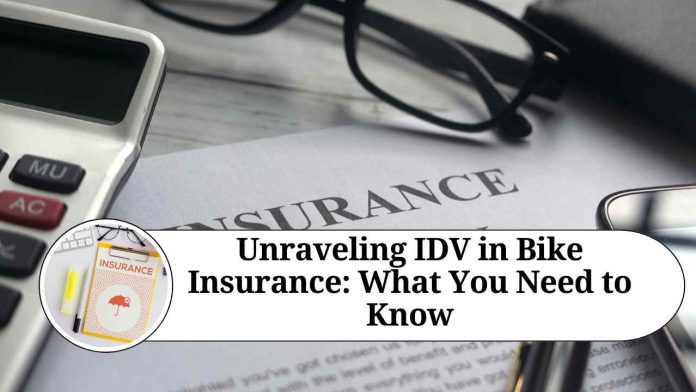Introduction
When it comes to insuring your precious two-wheeler, there are several factors to consider. One crucial aspect of bike insurance is the Insured Declared Value (IDV). IDV plays a significant role in determining the coverage and the premium of your bike insurance policy. In this blog post, we will delve into the concept of IDV in bike insurance, its importance, and how it affects your overall insurance experience.
Understanding IDV:
IDV, or Insured Declared Value, is the approximate market value of your bike that an insurance company considers when providing coverage against theft or total loss. It represents the maximum sum that you can claim from the insurance provider in case of these unfortunate events. The IDV is calculated based on the manufacturer’s listed selling price and depreciation.
Importance of IDV:
Determining Insurance Premium: The IDV directly affects the premium amount you pay for your bike insurance. As the IDV increases, the premium also tends to rise, as it indicates a higher replacement cost for the insurance company in case of a claim.
Adequate Coverage: IDV helps ensure that you have adequate coverage for your bike. Opting for a higher IDV means you will be reimbursed with a higher amount in case of theft or total loss. This ensures you can replace your bike without significant financial burden.
Negotiating Total Loss Settlement: In case of a total loss, where the cost of repairs exceeds a certain percentage of the IDV (typically 75% or more), the insurance company may consider the bike a “total loss” and provide a settlement amount based on the IDV. Having a realistic and accurate IDV ensures a fair and satisfactory settlement.
Factors Influencing IDV:
Age of the Bike: As a bike ages, its value depreciates. The IDV decreases over time, reflecting the reduced market value due to wear and tear.
Model and Make: The brand, model, and make of the bike also impact the IDV. Premium bikes and those with higher market values tend to have a higher IDV.
Modifications and Accessories: If you have made any modifications or added accessories to your bike, their value may be considered separately when calculating the IDV.
Geographic Location: The IDV can also vary based on the geographical location of your residence. Factors like theft rates, accident statistics, and repair costs in your area influence the IDV.
Tips for Choosing the Right IDV:
Research Market Values: Before renewing or buying bike insurance, research the current market value of your bike model. This will help you determine a realistic and appropriate IDV.
Balance between Premium and Coverage: While it might be tempting to opt for a lower IDV to reduce the premium, it’s crucial to strike a balance between affordability and sufficient coverage. Underinsuring your bike could lead to financial constraints during a claim.
Consult with Insurance Professionals: If you’re uncertain about the IDV calculation or have specific concerns, it’s always a good idea to consult with insurance professionals who can guide you through the process and provide expert advice.
Conclusion
IDV is an essential element of bike insurance, as it determines the coverage and the premium amount you pay. Understanding how IDV works and its impact on your insurance policy can help you make informed decisions while selecting appropriate coverage for your two-wheeler. By ensuring a realistic and accurate IDV, you can safeguard your bike against theft, total loss, and unexpected expenses, providing you with peace of mind on the road.
Read more useful content:
Frequently Asked Questions (FAQs)
Q1: What does IDV stand for in bike insurance?
A: IDV stands for Insured Declared Value.
Q2: What is the purpose of IDV in bike insurance?
A: The purpose of IDV is to determine the approximate market value of your bike, which is considered by the insurance company when providing coverage against theft or total loss.
Q3: How is IDV calculated in bike insurance?
A: IDV is calculated based on the manufacturer’s listed selling price of the bike and its age, considering depreciation. The depreciation percentage is applied to the bike’s ex-showroom price to arrive at the IDV.
Q4: How does IDV affect the premium of my bike insurance policy?
A: Generally, as the IDV increases, the premium amount also tends to rise. This is because a higher IDV indicates a higher replacement cost for the insurance company in case of a claim.
Q5: Can I choose the IDV for my bike insurance?
A: No, the IDV is calculated based on predefined factors and is determined by the insurance company. However, you can choose an insurance policy with an IDV that aligns with the current market value of your bike.
Q6: Does the IDV change over time?
A: Yes, the IDV decreases over time as the bike ages and its value depreciates. The depreciation is based on a standard rate set by the insurance industry.
Q7: What happens if I underinsure my bike by opting for a lower IDV?
A: Underinsuring your bike by choosing a lower IDV can lead to financial constraints during a claim. In such cases, you may not receive adequate compensation to replace your bike, and you might have to bear a significant portion of the cost.
Q8: Can I increase the IDV of my bike insurance policy?
A: In most cases, you can request to increase the IDV of your bike insurance policy. However, it is subject to approval from the insurance company, and it may result in a higher premium.
Q9: Are modifications and accessories considered when calculating the IDV?
A: Yes, if you have made modifications or added accessories to your bike, their value may be considered separately when calculating the IDV. It’s important to provide accurate information about any modifications or accessories to ensure proper coverage.
Q10: Can I negotiate the IDV with the insurance company?
A: The IDV is usually determined by the insurance company based on predefined factors. However, if you believe that the calculated IDV is significantly lower than the actual market value of your bike, you can try negotiating with the insurance company to reconsider the IDV.




















